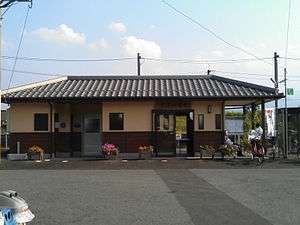Teruoka Station
Teruoka Station 光岡駅 | |
|---|---|
 Teruoka Station in 2007 | |
| Location | Japan |
| Coordinates | 33°19′39″N 130°55′12″E / 33.32763611°N 130.9199722°ECoordinates: 33°19′39″N 130°55′12″E / 33.32763611°N 130.9199722°E |
| Operated by |
|
| Line(s) | ■ Kyūdai Main Line |
| Distance | 45.2 km from Kurume |
| Platforms | 1 island platform |
| Tracks | 2 |
| Construction | |
| Structure type | At grade |
| Other information | |
| Status | Unstaffed |
| Website | Official website |
| History | |
| Opened | 3 March 1934 |
| Traffic | |
| Passengers (FY2015) | 114 daily |
| Location | |
 Teruoka Station Location within Japan | |
Teruoka Station (光岡駅 Teruoka-eki) is a railway station in Hita, Ōita Prefecture, Japan. It is operated by JR Kyushu and is on the Kyudai Main Line.[1][2]
Lines
The station is served by the Kyūdai Main Line and is located 45.2 km from the starting point of the line at Kurume.[3]
Layout
The station consists of an island platform serving two tracks with a siding. The station building is a modern structure but built in traditional Japanese style with a tiled roof. It is unstaffed and serves only as a waiting room. Access to the island platform is by means of a level crossing.[3][2][4]
 The old station building. This picture was taken in 2005
The old station building. This picture was taken in 2005
Adjacent stations
| « | Service | » | ||
|---|---|---|---|---|
| Kyūdai Main Line | ||||
| Yoake | Local | Hita | ||
Note: Since July 2017, the line after Teruoka has been cut due to a bridge collapse. The connection between Teruoka and Hita is now made by a JR bus service.[5]
History
Japanese Government Railways (JGR) had opened the Kyudai Main Line on 24 December 1928 with a track between Kurume and Chikugo-Yoshii and had extended the line east to Yoake by 12 March 1932. In a further phase of expansion, the track was extended east with Hita opening as the eastern terminus on 3 March 1934. Teruoka opened on the same day as an intermediate station on the track. With the privatization of Japanese National Railways (JNR), the successor of JGR, on 1 April 1987, JR Kyushu took over control of the station.[6][7]
In July 2017, torrential rainfall led to the railway bridge across the Kagetsugawa River about 1 km east of the station being swept away, cutting the line. Through service between Teruoka and the next station at Hita were suspended and the connection is now being made by a bus.[5] JR Kyushu said it intended to resume service by the summer of 2018[8] but later stated that it could be a long time before service is restored.[9]
 The collapsed bridge over the Kagetsugawa River.
The collapsed bridge over the Kagetsugawa River.
Passenger statistics
In fiscal 2015, there were a total of 41,755 boarding passengers, giving a daily average of 114 passengers.[10]
See also
References
- ↑ "JR Kyushu Route Map" (PDF). JR Kyushu. Retrieved 23 February 2018.
- 1 2 "光岡" [Teruoka]. hacchi-no-he.net. Retrieved 8 April 2018.
- 1 2 Kawashima, Ryōzō (2013). 図説: 日本の鉄道 四国・九州ライン 全線・全駅・全配線・第4巻 福岡エリア [Japan Railways Illustrated. Shikoku and Kyushu. All lines, all stations, all track layouts. Volume 4 Fukuoka Area] (in Japanese). Kodansha. p. 38, 73. ISBN 9784062951630.
- ↑ "光岡" [Teruoka]. Retrieved 8 April 2018. Blog entry with good photographic coverage of station facilities.
- 1 2 "Death toll from Kyushu rains hits 22 as searches, evacuations continue". Mainichi Shimbun website. 10 July 2017. Retrieved 8 April 2018.
- ↑ Ishino, Tetsu et al. (eds.) (1998). 停車場変遷大事典 国鉄・JR編 [Station Transition Directory - JNR/JR] (in Japanese). I. Tokyo: JTB Corporation. p. 227. ISBN 4533029809.
- ↑ Ishino, Tetsu et al. (eds.) (1998). 停車場変遷大事典 国鉄・JR編 [Station Transition Directory - JNR/JR] (in Japanese). II. Tokyo: JTB Corporation. p. 739. ISBN 4533029809.
- ↑ "平成29年7月九州北部豪雨による久大本線・日田彦山線の状況について" [The situation of the Kyudai and Hitahikosan Lines after the torrential rain in Northern Kyushu in July 2017] (PDF). JR Kyushu. 31 July 2017. Retrieved 8 April 2018. See also for pictures of the collapsed bridge.
- ↑ "Suspension of the train service" (PDF). JR Kyushu. September 2017. Retrieved 8 April 2018.
- ↑ "平成28年版 大分県統計年鑑 11 運輸および通信" [Oita Prefecture Statistics Yearbook 2016 Edition Section 11 Transportation and Comunications]. Oita Prefectural Government website. Retrieved 8 April 2018. See table 128 Transport situation by individual railway stations (JR Kyushu JR Freight).
| Wikimedia Commons has media related to Teruoka Station. |
External links
- Teruoka (JR Kyushu)(in Japanese)